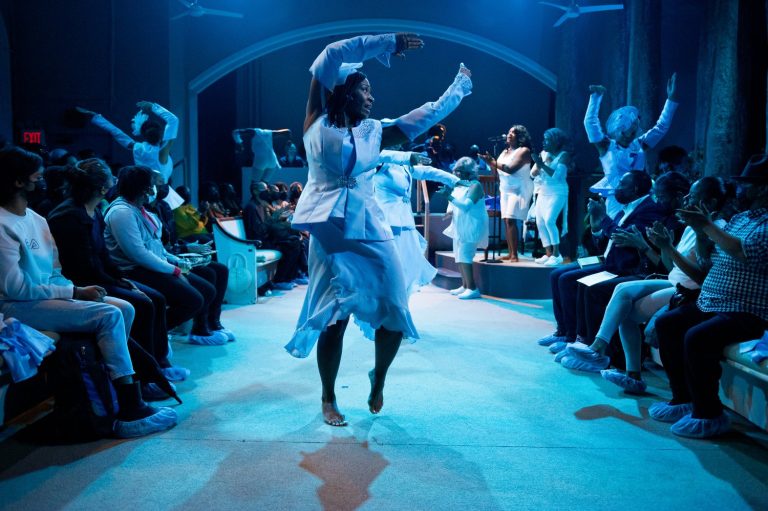
[ad_1]

This culminates a few times in an impassioned outburst turned breathtaking monologue. These monologues contain some of the most harrowing lines of dialogue, ones that cut directly at the heart of the play’s meaning.
“I’d give my left foot to be able to agree with myself — my many selves. To reconcile my many thoughts, to align my worth with something real,” they say.
“Does my confusion mean that I’m bad as a person?” they ask.
It’s a visceral representation of the confusion and guilt that accompanies asking questions about faith, and it encapsulates so much and so well the present feeling many have when approaching any long-held religion, especially if it’s one that’s close to their family or culture.
That’s the other beautiful part of “(pray)” — it’s tied so closely to the religious practices of Black women and evangelical Christianity that it’s able to look back on history with sadness, anger and celebration.
The play contains two readings, both from the essay “My Mother Could Send up the Most Powerful Prayer: The Role of African American Slave Women in Evangelical Christianity” by Sherry L. Abbott.
The readings do as the essay’s title suggests: they herald Black women as trailblazers of evangelical Christianity and as pillars of strength in their communities while their people were enslaved. They used it as a source of strength and comfort in times of suffering; they helped preserve tradition that’s lasted to the present day.
“Black women and femmes played a massive role in evangelical Christianity in the Antebellum South through to now,” douglas said, “so why don’t we go ahead and celebrate that and shed light on that? Not to complain about not being noticed, but to be able to claim and celebrate the feminine divine and the power of it throughout history.”
The other fundamental connection to Black evangelical Christianity is in the use of traditional hymns, which douglas researched extensively and uses throughout the piece.
“The lyrics I chose were the ones that were literally related to things I was already writing,” they said. “It felt like the universe was just sort of matchmaking.”
These hymns are evocative on their own — aided by the performances of an entire cast of stunning vocalists — but their impact is only emphasized when paired with the show’s original compositions, which at times moved me to tears.
When planning for these songs, douglas asked composers Starr Busby and JJJJJerome Ellis to consider a question themselves: “What would a new Negro spiritual sound like?”
The result involves an electronic sound and lyrics that include beliefs beyond those of evangelical Christianity.
Language is a powerful tool douglas utilizes overall. In a playful moment, the words of familiar hymns are reversed: instead of “this little light of mine, I’m gonna let it shine,” the singers proclaim, “this little shine of mine, I’m gonna let it light.”
Many such replacements are made elsewhere, religious jargon replaced with more generic words that sound similar.
“From an Afrofuturist standpoint, it’s using language as technology, to dig into the themes and concepts of the word,” douglas said.
“Amen” in the show is replaced with “again,” used in a rousing call-and-response at the end of the service. Because it’s being used as technology, each replacement word is chosen with intention even beyond its sound.
“First, and this is just how I respond to the word, it has ‘men’ in it, and this work is too femme for that,” douglas said, laughing.
But “(pray)” more than anything celebrates community and a willingness to keep learning, even if answers aren’t readily apparent. It encourages embracing the past and making peace with asking difficult questions.
“An amen has such a finality to it; it feels like the end,” douglas said. “There’s something about spirituality to me that invites repetition and invites continuation.”
(pray) is currently on view at Greenwich House until Oct. 28.
[ad_2]
Source link